1996 PONTIAC PONTIAC brake light
[x] Cancel search: brake lightPage 6 of 370
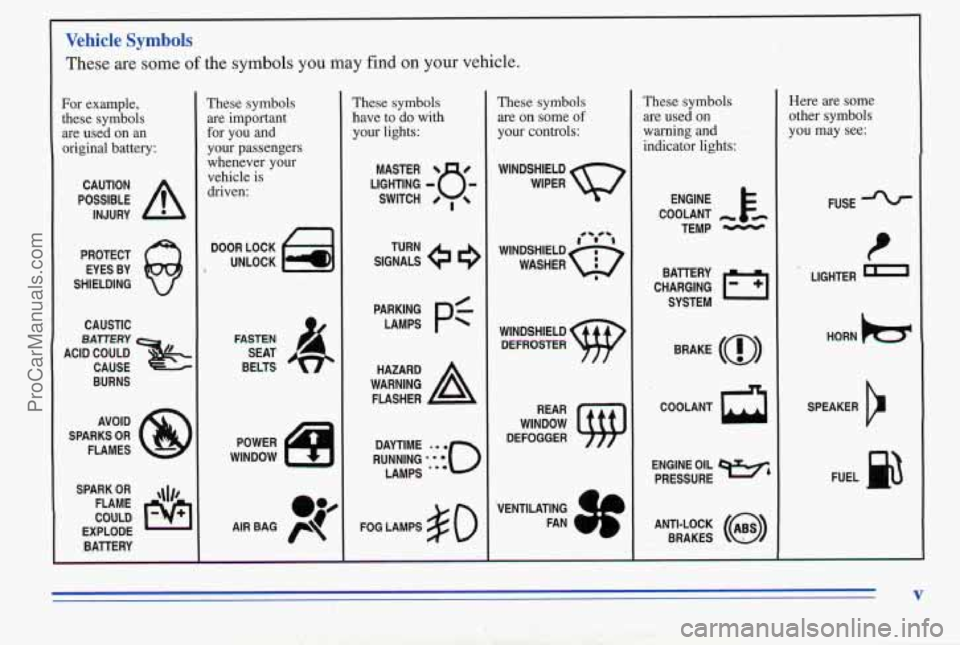
1
Vehicle Symbols
These are some of the symbols you may find on your vehicle.
For example,
these symbols are used on an
original battery:
POSSIBLE A
CAUTION
INJURY
PROTECT EYES BY
SHIELDING
CAUSTIC
ACIEEZ CAUSE
BURNS
AVOID
SPARKS
OR
FLAMES
SPARK
OR ,\I/,
COULD FLAME
EXPLODE BATTERY
These symbols
are important
for you and
your passengers
whenever your
vehicle is driven:
DOOR LOCK
UNLOCK
FASTEN SEAT
BELTS
POWER
WINDOW
c
These symbols
have to do with
your lights:
SIGNALS e 9
TURN
PARKING
PC
LAMPS
FOG LAMPS $0
These symbols
are
on some of
your controls:
WINDSHIELD
WIPER
'VENTILATING
FAN
These symbols
are used on
warning and
indicator lights:
COOLANT -
TEMP -
CHARGING 1-1
BATTERY
SYSTEM
BRAKE
(0)
COOLANT a
ENGINE OIL w,
PRESSURE
ANTI-LOCK
(@)
BRAKES
Here are some
other symbols
you may see:
FUSE
P
LIGHTER m
HORN )cr
SPEAKER
b
FUEL e3
V
ProCarManuals.com
Page 100 of 370
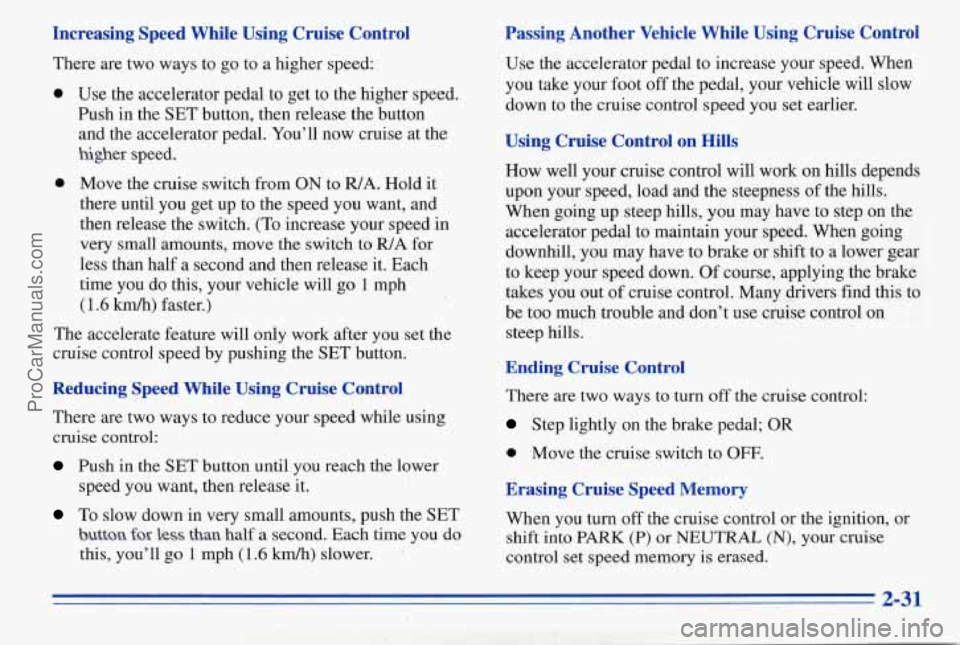
Increasing Speed While Using Cruise Control
There are two ways to go to a higher speed:
0
0
Use the accelerator pedal to get to the higher speed.
Push in the
SET button, then release the button
and the accelerator pedal. You’ll now cruise at the
higher speed.
Move the cruise switch from
ON to WA. Hold it
there until you get up to the speed you want, and
then release the switch.
(To increase your speed in
very small amounts, move the switch to
R/A for
less than half a second and then release it. Each
time you do this, your vehicle will go 1 mph
(1.6 km/h) faster.)
The accelerate feature will only work after
you set the
cruise control speed by pushing the
SET button.
Reducing Speed While Using Cruise Control
There are two ways to reduce your speed while using
cruise control:
Push in the SET button until you reach the lower
speed you want, then release it.
To slow down in very small amounts, push the SET
button for Less than half a second. Each time you do
this, you’ll go 1 mph
(1.6 km/h) slower.
Passing Another Vehicle While Using Cruise Control
Use the accelerator pedal to increase your speed. When
you take your foot off the pedal, your vehicle will slow
down to the cruise control speed you set earlier.
Using Cruise Control on Hills
How well your cruise control will work on hills depends
upon your speed, load and the steepness of the hills.
When going up steep hills, you may have to step on the
accelerator pedal to maintain your speed. When going
downhill, you may have to brake or shift to a lower gear
to keep your speed down. Of course, applying the brake
takes you out
of cruise control. Many drivers find this to
be
too much trouble and don’t use cruise control on
steep hills.
Ending Cruise Control
There are two ways to turn off the cruise control:
Step lightly on the brake pedal; OR
0 Move the cruise switch to OFF.
Erasing Cruise Speed Memory
When you turn off the cruise control or the ignition, or
shift into
PARK (P) or NEUTRAL (N), your cruise
control set speed memory
is erased.
2-31
ProCarManuals.com
Page 102 of 370

Daytime Running Lamps (Option)
Daytime Running Lamps (DRL) can make it easier for
others to see the front
of your vehicle during the day.
DRL can be helpful in many different driving
conditions, but they can be especially helpful in the
short periods after dawn and before sunset.
A light sensor on top of the instrument panel makes the
DRL work, so be sure it isn’t covered.
The DRL system will make your low-beam headlamps
come on at a reduced brightness when:
0 The ignition is on,
0 The headlamp switch is off, and
0 The parking brake is released.
When
the DRL aye on, only your low-beam headlamps
will be on. The taillamps, sidemarker and other lamps
won’t be on.
Your instrument panel won’t be lit up either.
When it’s dark enough outside, your low-beam headlamps
will change to
full brightness. The other lamps that come
on with your headlamps will also
come on. When
it’s bright enough outside, the regular lamps will
go out, and your low-beam headlamps will change to
the reduced brightness of DRL.
To idle your vehicle with the DIU off, set the parking
brake while the ignition is in the
OFF or LOCK
position. Then start your vehicle. The DRL will stay
off until you release the parking brake.
As with any vehicle, you should turn on the regular
headlamp system when you need it.
Fog Lamps
To turn the fog lamps on, press the top of the fog lamp
switch
(C). Press the bottom of the switch to turn the fog
lamps
off. Your parking lamps must be on, or your fog
lamps won’t come on.
The fog lamps will
go off whenever you change to
high-beam headlamps. When you return to low beams,
the fog lamps will come on again.
. 2-33
ProCarManuals.com
Page 117 of 370

Brake System Warning Light
Your Pontiac's hydraulic brake system is divided into
two pats. If one part isn't working, the other pa;t.can
still work and stop you. For
good braking, though, you
need both parts working well.
If the warning light comes on, there could be a brake
problem. Have your brake system inspected right away.
BRAKE
This light should come on
briefly when you turn the
ignition key to
RUN. If it
doesn't come on then, have
it fixed
so it will be ready to
warn you if there's a
problem.
If the light comes on while you are driving, pull off the
road and stop carefully.
You may notice that the pedal is
harder to push. Or, the pedal may go closer to the floor.
It may take longer to stop. If the light is still on; or if the anti-lock brake system warning light
is flashing,
have
the vehicle towed
for service. (See "Anti-Lock Brake
System Warning Light" and "Towing Your Vehicle" in
the Index.)
A CAUTION: -
~ ~~~~ ~ ~ ~~
Your brake system may not be working properly
if the brake system warning light is on. Driving
with the brake system warning light on can
lead
to an accident. If the light is still on or if the
anti-lock brake system warning light
is flashing
after you've pulled.off the
road and stopped
carefully, have the vehicle towed for service.
When the ignition is on, the brake system warning light
will also come on when you set your
parking brake. The
light will stay on if your parking brake doesn't release
fully.
If it stays on after your parking brake is fdly
released,
it means you have a brake problem.
ProCarManuals.com
Page 118 of 370
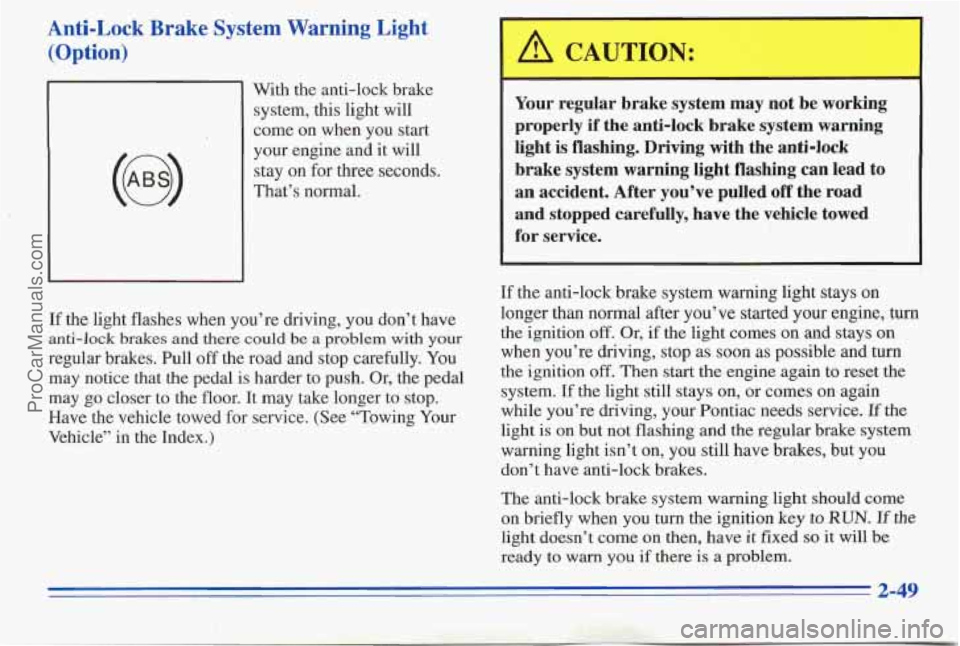
Anti-Lock Brake System Warning Light (Option)
(@)
With the anti-lock brake
system, this light will
come on when you start
your engine and it will
stay
on for three seconds.
That’s normal.
If the light flashes when you’re ( ving, you don’t have
anti-lock brakes and there could be a problem with your
regular brakes. Pull off the road and stop carefully.
You
may notice that the pedal is harder to push. Or, the pedal
may
go closer to the floor. It may take longer to stop.
Have the vehicle towed for service. (See ‘Towing Your
Vehicle’’ in the Index.)
A CAUTION:
I
Your regular brake system may not be working
properly if the anti-lock brake system warning
light is flashing. Driving with the anti-lock
brake system warning light flashing can lead to
an accident. After you’ve pulled
off the road
and stopped carefully, have the vehicle towed
for service.
If the anti-lock brake system warning light stays on
longer than normal after you’ve started your engine, turn
the ignition
off. Or, if the light comes on and stays on
when you’re driving, stop as soon as possible and turn
the ignition
off. Then start the engine again to reset the
system.
If the light still stays on, or comes on again
while you’re driving, your Pontiac needs service.
If the
light
is on but not flashing and the regular brake system
warning light isn’t on, you still have brakes, but you
don’t have anti-lock brakes.
The anti-lock brake system warning light should come
on briefly when you turn
the ignition key to RUN. If the
light doesn’t come on then, have it fixed so it will be
ready to
warn you if there is a problem.
ProCarManuals.com
Page 119 of 370
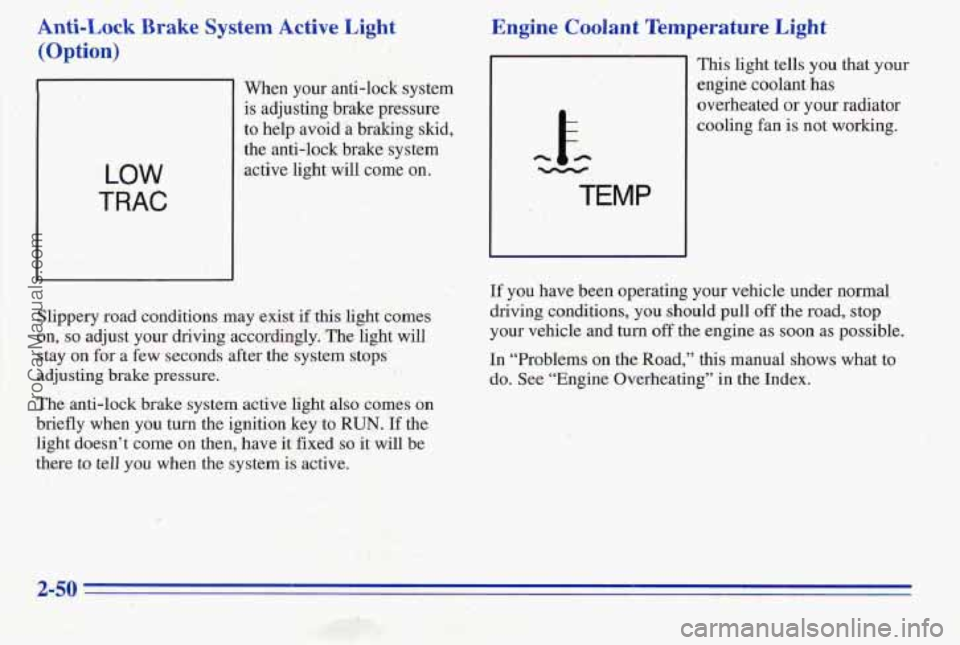
Anti-Lock Brake System Active Light
(Option)
Men your anti-lock system
is adjusting brake pressure
to help avoid a braking skid,
the anti-lock brake system
active light will come on.
Engine Coolant Temperature Light
h E- -
c. TEMP
This light tells you that your
engine coolant,
has
overheated or your radiator
c-ooling €an
is not working.
.. . ..
' .. 5
.. . .
Slippery road conditions may exist if this light comes
on,
so adjust your driving accordingly. The light will
stay un for a few seconds after the system stops
adjusting brake pressure.
If you have been operatmg your vehicle under normal
driving conditions, you should pull off the road, stop
your vehicle and turn off the engine as soon as possible.
In "Problems on the Road," this manual shows what to
do. See "Engine Overheating" in the Index.
The anti-lock brake system active light also come,s on
briefly when you turn the ignition key to RUN. If the
'light doesn't come on then, have it fixed
so it will be
there to tell you when the system is active.
ProCarManuals.com
Page 162 of 370
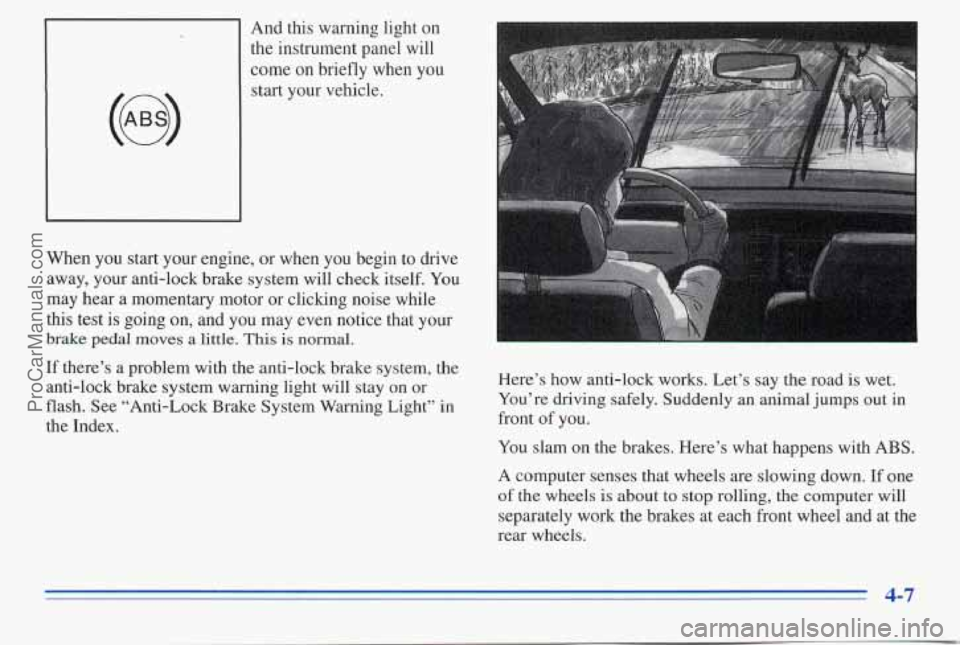
And this warning light on
the instrument panel will
come on briefly when you
start your vehicle.
When you start your engine, or when you begin to drive
away, your anti-lock brake system will check itself. ‘You
may hear a momentary motor or clicking noise while
this test
is going on, and you may even notice that your
brake pedal moves a little. This is normal.
If there’s a problem with the anti-lock brake system, the
anti-lock brake system warning light will stay on or
flash. See “Anti-Lock Brake System Warning Light” in
the Index. Here’s how anti-lock works. Let’s say
the road is wet.
You’re driving safely. Suddenly an animal jumps out in
front of you.
You slam on the brakes. Here’s what happens with
ABS.
A computer senses that wheels are slowing down. If one
of the wheels is about to stop rolling, the computer will
separately work the brakes at each front wheel and at the
rear wheels.
4-7
ProCarManuals.com
Page 163 of 370
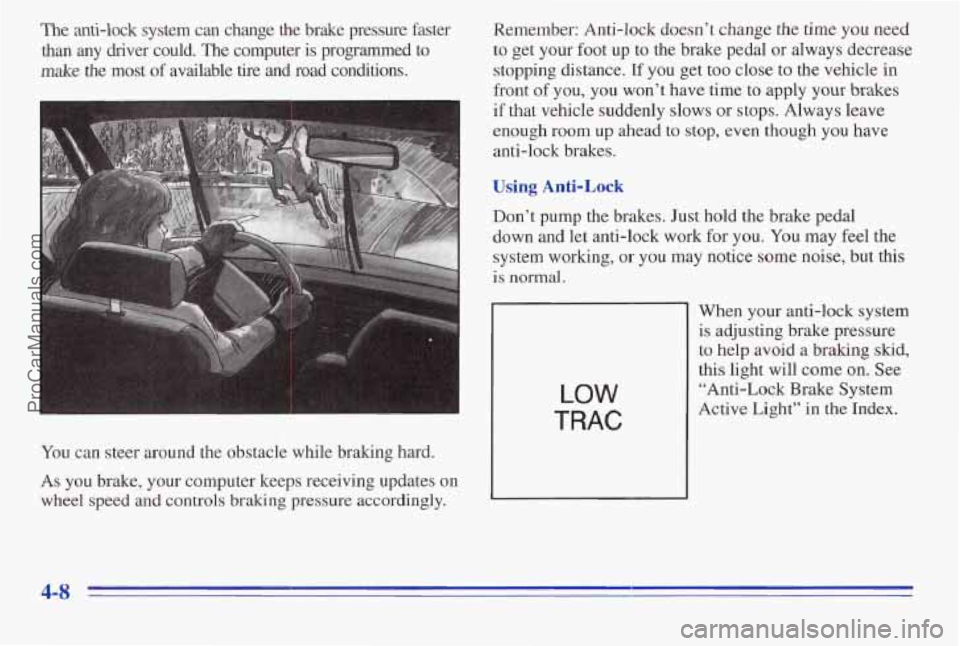
The anti-lock system can change the brake pressure faster
than any driver could. The computer is programmed to
make the most of available tire and road conditions.
You can steer around the obstacle while braking hard.
As you brake, your computer keeps receiving updates on
wheel speed and controls
braking pressure accordingly. Remember: Anti-lock doesn’t
change the time you
need
to get your foot up to the brake pedal or always decrease
stopping distance. If you get too close
to the vehicle in
front
of you, you won’t have time to apply your brakes
if that vehicle suddenly slows or stops. Always leave
enough room up ahead to
stop, even though you have
anti-lock brakes.
Using Anti-Lock
Don’t pump the brakes. Just hold the brake pedal
down and let anti-lock
work for you. You may feel the
system working,
or you may notice some noise, but this
is normal.
LOW
TRAC
When your anti-lock system
is adjusting brake pressure
to help avoid a braking
skid,
this light will come on. See
“Anti-Lock Brake System
Active
Light” in the Index.
4-8
ProCarManuals.com